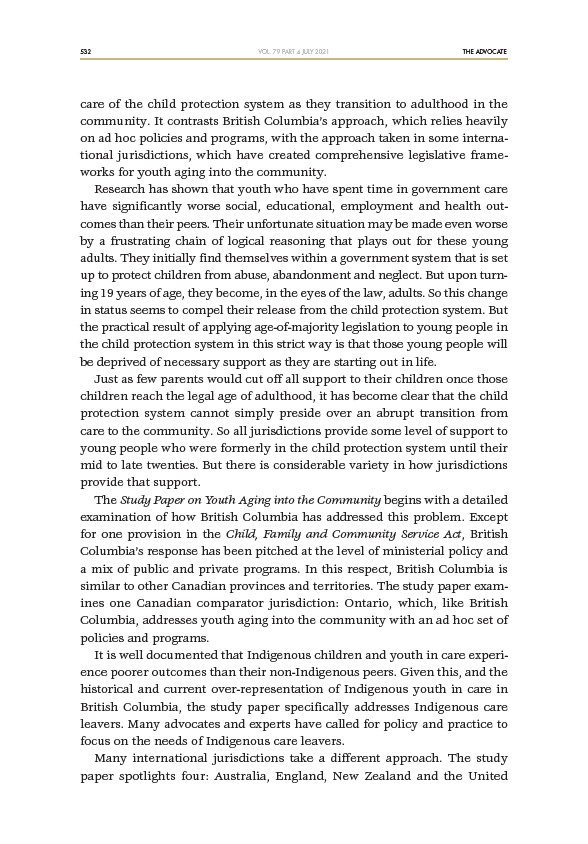
532 THE ADVOCATE
VOL. 79 PART 4 JULY 2021
care of the child protection system as they transition to adulthood in the
community. It contrasts British Columbia’s approach, which relies heavily
on ad hoc policies and programs, with the approach taken in some international
jurisdictions, which have created comprehensive legislative frameworks
for youth aging into the community.
Research has shown that youth who have spent time in government care
have significantly worse social, educational, employment and health outcomes
than their peers. Their unfortunate situation may be made even worse
by a frustrating chain of logical reasoning that plays out for these young
adults. They initially find themselves within a government system that is set
up to protect children from abuse, abandonment and neglect. But upon turning
19 years of age, they become, in the eyes of the law, adults. So this change
in status seems to compel their release from the child protection system. But
the practical result of applying age-of-majority legislation to young people in
the child protection system in this strict way is that those young people will
be deprived of necessary support as they are starting out in life.
Just as few parents would cut off all support to their children once those
children reach the legal age of adulthood, it has become clear that the child
protection system cannot simply preside over an abrupt transition from
care to the community. So all jurisdictions provide some level of support to
young people who were formerly in the child protection system until their
mid to late twenties. But there is considerable variety in how jurisdictions
provide that support.
The Study Paper on Youth Aging into the Community begins with a detailed
examination of how British Columbia has addressed this problem. Except
for one provision in the Child, Family and Community Service Act, British
Columbia’s response has been pitched at the level of ministerial policy and
a mix of public and private programs. In this respect, British Columbia is
similar to other Canadian provinces and territories. The study paper examines
one Canadian comparator jurisdiction: Ontario, which, like British
Columbia, addresses youth aging into the community with an ad hoc set of
policies and programs.
It is well documented that Indigenous children and youth in care experience
poorer outcomes than their non-Indigenous peers. Given this, and the
historical and current over-representation of Indigenous youth in care in
British Columbia, the study paper specifically addresses Indigenous care
leavers. Many advocates and experts have called for policy and practice to
focus on the needs of Indigenous care leavers.
Many international jurisdictions take a different approach. The study
paper spotlights four: Australia, England, New Zealand and the United